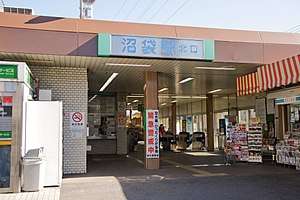Numabukuro Station
Numabukuro Station (沼袋駅, Numabukuro-eki) is a railway station on the Seibu Shinjuku Line in Nakano, Tokyo, Japan, operated by the private railway operator Seibu Railway.
SS06 Numabukuro Station 沼袋駅 | |
|---|---|
 North entrance, February 2006 | |
| Location | Nakano, Tokyo Japan |
| Operated by | Seibu Railway |
| Line(s) | Seibu Shinjuku Line |
| Connections |
|
| Other information | |
| Station code | SS06 |
| History | |
| Opened | 1927 |
| Traffic | |
| Passengers (FY2013) | 19,720 daily |
Lines
Numabukuro Station is served by the 47.5 km Seibu Shinjuku Line from Seibu-Shinjuku in Tokyo to Hon-Kawagoe in Saitama Prefecture.[1] Located between Araiyakushi-mae and Nogata, it is 6.1 km from the Seibu-Shinjuku terminus.[1]
During the daytime off-peak, the station is served by six trains per hour in either direction.
Station layout
The station consists of a two ground-level side platforms serving two tracks, with centre tracks in between for non-stop trains.[2]
 South entrance, November 2006
South entrance, November 2006 General view of the station, November 2006
General view of the station, November 2006
Platforms
| 1 | ■ Seibu Shinjuku Line | for Takadanobaba and Seibu-Shinjuku |
| 2 | ■ Seibu Shinjuku Line | for Kodaira,Tokorozawa, and Hon-Kawagoe |
Adjacent stations
| « | Service | » | ||
|---|---|---|---|---|
| Seibu Shinjuku Line | ||||
| Koedo limited express: Does not stop at this station | ||||
| Commuter express: Does not stop at this station | ||||
| Express: Does not stop at this station | ||||
| Semi express: Does not stop at this station | ||||
| Araiyakushi-mae | Local | Nogata | ||
History
The station opened on 16 April 1927.[1]
Station numbering was introduced on all Seibu Railway lines during fiscal 2012, with Numabukuro Station becoming "SS06".[3]
Future developments
In order to ease congestion and improve the safety of the railway in the local area, plans have been produced to divert the tracks between Nakai Station and Nogata Station underground. Consequently, the existing station complex is expected to be replaced by an underground station.[4] Approval for the plan was granted in April 2013.[5]
Passenger statistics
In fiscal 2013, the station was the 53rd busiest on the Seibu network with an average of 19,720 passengers daily.[6]
The passenger figures for previous years are as shown below.
| Fiscal year | Daily average |
|---|---|
| 2000 | 20,768[1] |
| 2009 | 20,027[7] |
| 2010 | 19,465[8] |
| 2011 | 19,068[8] |
| 2012 | 19,632[6] |
| 2013 | 19,720[6] |
Surrounding area
References
- Terada, Hirokazu (July 2002). データブック日本の私鉄 [Databook: Japan's Private Railways]. Japan: Neko Publishing. p. 202. ISBN 4-87366-874-3.
- Kawashima, Ryozo (March 2011). 日本の鉄道 中部ライン 全線・全駅・全配線 第12巻 東京都心北部 [Railways of Japan - Chubu Line - Lines/Stations/Track plans - Vol 12 Northern Central Tokyo]. Japan: Kodansha. p. 35/59. ISBN 978-4-06-270072-6.
- 西武線全駅で駅ナンバリングを導入します [Station numbering to be introduced at all Seibu stations] (PDF). News Release (in Japanese). Japan: Seibu Railway. 23 February 2012. Archived from the original (PDF) on 24 September 2015. Retrieved 2 April 2013.
- 西武鉄道新宿線(中井駅~野方駅間) 連続立体交差化計画について [Information regarding the Seibu Shinjuku line multi-grade separation plans. (Between Nakai and Nogata stations)] (PDF) (in Japanese). Japan: Nakano City. Archived from the original (PDF) on 23 September 2015. Retrieved 16 July 2014.
- 工事の概要 [Summary of the construction] (in Japanese). Japan: Seibu Railway. Archived from the original on 11 October 2014. Retrieved 16 July 2014.
- 駅別乗降人員 2013(平成25)年度 1日平均 [Average daily station usage figures (fiscal 2013)] (PDF) (in Japanese). Japan: Seibu Railway. Archived from the original (PDF) on 14 July 2014. Retrieved 22 June 2014.
- 駅別乗降人員 2010(平成22)年度 1日平均 [Average daily station usage figures (fiscal 2010)] (PDF) (in Japanese). Japan: Seibu Railway. Archived from the original (PDF) on 26 June 2011. Retrieved 2 April 2013.
- 駅別乗降人員 2011(平成23)年度 1日平均 [Average daily station usage figures (fiscal 2011)] (PDF) (in Japanese). Japan: Seibu Railway. Archived from the original (PDF) on 1 November 2012. Retrieved 2 April 2013.
External links
| Wikimedia Commons has media related to Numabukuro Station. |
- Numabukuro Station information (Seibu Railway) (in Japanese)